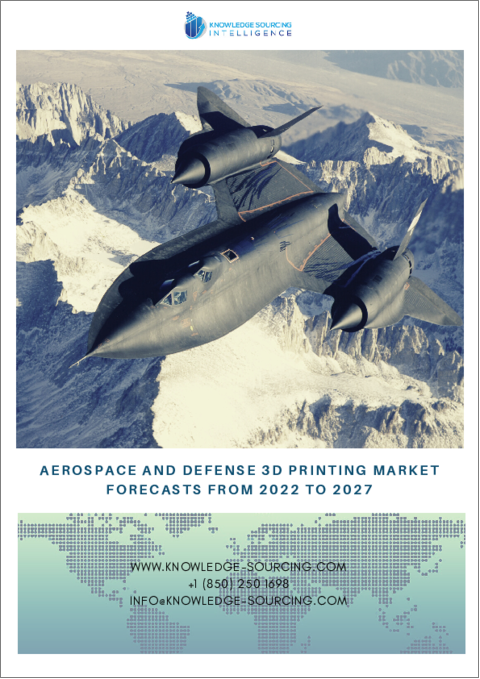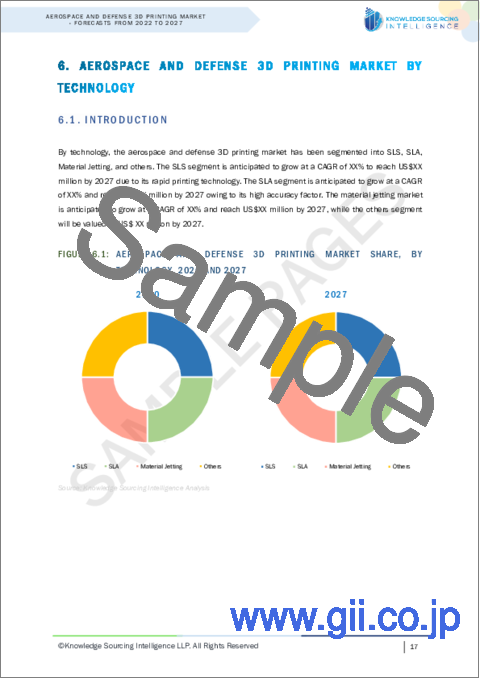|
|
市場調査レポート
商品コード
1087148
航空宇宙・防衛用3D印刷:世界市場予測(2022年~2027年)Aerospace and Defense 3D Printing Market - Forecasts from 2022 to 2027 |
||||||
|
● お客様のご希望に応じて、既存データの加工や未掲載情報(例:国別セグメント)の追加などの対応が可能です。 詳細はお問い合わせください。 |
|||||||
| 航空宇宙・防衛用3D印刷:世界市場予測(2022年~2027年) |
|
出版日: 2022年05月27日
発行: Knowledge Sourcing Intelligence
ページ情報: 英文 125 Pages
納期: 即日から翌営業日
|
- 全表示
- 概要
- 目次
世界の航空宇宙・防衛用3D印刷の市場規模は、2020年に14億1,076万米ドルとなり、予測期間中に23.12%のCAGRで拡大し、2027年に60億5,113万3,000米ドルになると予測されています。
当レポートでは、航空宇宙・防衛用3D印刷の世界市場を調査し、市場規模や予測、市場の促進要因および課題、市場動向、セグメント別の市場分析、競合情勢、主要企業のプロファイルなどの体系的な情報を提供しています。
目次
第1章 イントロダクション
- 市場の定義
- 市場セグメンテーション
第2章 調査手法
- 調査データ
- 仮定
第3章 エグゼクティブサマリー
- 調査のハイライト
第4章 市場力学
- 市場促進要因
- 市場抑制要因
- ポーターのファイブフォース分析
- 供給企業の交渉力
- 買い手の交渉力
- 代替品の脅威
- 新規参入者の脅威
- 競争企業間の敵対関係
- 業界のバリューチェーン分析
第5章 航空宇宙・防衛用3D印刷市場:材料別
- イントロダクション
- 金属
- ポリマー
- セラミック
第6章 航空宇宙・防衛用3D印刷市場:技術別
- イントロダクション
- SLS
- SLA
- マテリアルジェッティング
- その他
第7章 航空宇宙・防衛用3D印刷市場:用途別
- イントロダクション
- プロトタイピング
- ツーリング
- 部品
- 備品
- コーティング
第8章 航空宇宙・防衛用3D印刷市場:地域別
- イントロダクション
- 北米
- 米国
- カナダ
- メキシコ
- 南米
- ブラジル
- アルゼンチン
- その他
- 欧州
- ドイツ
- フランス
- 英国
- スペイン
- その他
- 中東とアフリカ
- サウジアラビア
- アラブ首長国連邦
- イスラエル
- その他
- アジア太平洋地域
- 中国
- インド
- 韓国
- 台湾
- タイ
- インドネシア
- 日本
- その他
第9章 競合情勢と分析
- 主要企業と戦略分析
- 新興企業と市場の有利性
- 合併、買収、合意、およびコラボレーション
- ベンダー競争力マトリックス
第10章 企業プロファイル
- Stratasys Ltd.
- 3D Systems, Inc.
- Materialise
- EOS Group
- SLM Solutions Group AG
- ENVISIONTEC, INC.
- Renishaw plc
- Extrude Hone (ExOne) Company
- Concept Laser GmbH (GE子会社)
- MTU Aero Engines
The aerospace and defense 3D printing market was valued at US$1,410.760 million in 2020 and is expected to grow at a CAGR of 23.12% over the forecast period to reach a market size of US$6,051.133 million by 2027.
A 3D printer uses a software program to receive a command and create a three-dimensional object, which is called additive manufacturing. In addition to aerospace and manufacturing, 3D printers are used in medical fields and in the medical field. As advanced technology 3D printers become available, the aerospace and defence industries' 3D printing capabilities should improve in the coming years Aerospace companies were among the first to adopt 3D printing technology. Today, the aerospace industry continues to be considered the one that is most adept at using 3D printing technologies. A multitude of factors contribute to this, such as faster production delivery, lower production quantities, and the ability to design for additive manufacturing. Several aerospace companies have already adopted this technology in their operations. Boeing is one such company that has been experimenting with 3D printing. In 2019, Boeing developed the first metal 3D printed satellite antenna using 3D printing for satellite production. Located in Israel, the antenna was designed by the Israeli satellite launch company Spacecom, which successfully launched AMOS 17. In the near future, 3D printing may have an increasing impact on the aerospace industry, thereby making the market more profitable.
Commercial aircraft, military aircraft, and space technology are examples of areas where the aerospace and defense (A&D) industries have adopted additive manufacturing technology. In the aircraft 3D printing industry, in both the commercial aviation and military aviation sectors, some of the current applications include building 3D printed PMA replacement parts and designing complex aerospace parts. The aerospace industry is a major market for the U.S. In 2019, combined sales for the aerospace and defense industry reached $909 billion, an increase of 6.7% over the previous year. The majority of this revenue, -- $399 billion -- was driven by shared supply chains, that support both aerospace and defense. (source: aia-aerospace.org). Based on these estimates, the aerospace industry generates significant investment and revenue, which impacts the growth of 3D printing in the field.
Growth Factors:
- A high growth rate is expected for the aircraft segment
Developing and designing an aircraft involves taking into account the aircraft's weight. Fuel consumption of lighter aircraft has decreased. There are low profits on aircraft, so aircraft that are more fuel-efficient are given preference. In technologically advanced aircraft, lightweight advanced materials - like components, parts, and airframes are used to create lightweight and advanced components without compromising strength or aerodynamics. Several companies, including Lockheed Martin Corporation and Arconic, have recently announced joint development agreements (JDA) to develop next-generation, advanced manufacturing processes, and advanced materials. As part of their future plans, the two companies will improve current and next-generation aerospace and defense solutions by designing lightweight material systems and incorporating advanced manufacturing technologies such as metal 3D printing. A combination of the factors described above has led to increased demand for newer generation aircraft, and may also drive the growth of the additive manufacturing industry. According to Boeing, the aircraft segment commanded the largest share of 3D printed parts during 2018.
Boeing (US) and Oerlikon (Switzerland) signed a five-year agreement in 2019 to support the development of titanium 3D printing processes. Airbus and Safran have made great progress with their Ariane6 rocket ;-using 3D printing, a single part of the injector head replaced 248 parts. Additionally, AM technology was used to successfully print a combustion chamber that was successfully tested. Relativity Space will also work with Lockheed Martin on a 2023 NASA mission, which will involve the construction of lightweight rockets customized for the mission. Airbus has developed a spacer panel for the A320 commercial aircraft that is 15% lighter than the original. The panel is located alongside the overhead storage compartments. A 3D-printed metal bracket from an aircraft, for example, could save 2.5 million gallons of fuel per year by reducing its weight by 50-80%. Such major developments by these companies are fuelling the growth of the market.
Restrain:
- High Cost
Global aerospace and defense 3D printing market growth, however, may be hindered by high acquisition costs associated with 3D printing and a lack of raw materials. In contrast to mills and injection mold presses, many 3D printers, including industrial printers, have relatively small build chambers. A large part would need to be sliced into sections and stitched together later, after the printer's build chamber is full. Due to the increased printing costs and the manual labor involved, the market growth will be curtailed.
The Impact of COVID-19 on the Aerospace and Defense 3D Printing Market
As COVID-19 spread quickly, the market's expectations were ruined. Adding to the industry's challenges, the pandemic weakened its sales to the lowest level in a decade. Lockdowns in several countries have caused disruptions in supply chains and operational activities, worsening the market conditions. Recent IATA estimates state that RPKs for the airline industry are expected to drop by 65.9% in 2020 as a result of the pandemic. Therefore, the market for aerospace and defense 3D printing is predicted to decline sharply in 2020, resulting in a crushing decline in sales.
Market Segmentation:
- By Material
Metals
Polymers
Ceramics
- By Technology
SLS
SLA
Material Jetting
Others
- By Application
Prototyping
Tooling
Parts
Fixtures
Coating
- By Geography
North America
- United States
- Canada
- Mexico
South America
- Brazil
- Argentina
- Others
Europe
- Germany
- France
- United Kingdom
- Spain
- Others
Middle East and Africa
- Saudi Arabia
- UAE
- Israel
- Others
Asia Pacific
- China
- India
- South Korea
- Taiwan
- Thailand
- Indonesia
- Japan
- Others
TABLE OF CONTENTS
1. INTRODUCTION
- 1.1. Market Definition
- 1.2. Market Segmentation
2. RESEARCH METHODOLOGY
- 2.1. Research Data
- 2.2. Assumptions
3. EXECUTIVE SUMMARY
- 3.1. Research Highlights
4. MARKET DYNAMICS
- 4.1. Market Drivers
- 4.2. Market Restraints
- 4.3. Porter's Five Forces Analysis
- 4.3.1. Bargaining Power of Suppliers
- 4.3.2. Bargaining Powers of Buyers
- 4.3.3. Threat of Substitutes
- 4.3.4. Threat of New Entrants
- 4.3.5. Competitive Rivalry in Industry
- 4.4. Industry Value Chain Analysis
5. AEROSPACE AND DEFENSE 3D PRINTING MARKET, BY MATERIAL
- 5.1. Introduction
- 5.2. Metals
- 5.3. Polymers
- 5.4. Ceramics
6. AEROSPACE AND DEFENSE 3D PRINTING MARKET, BY TECHNOLOGY
- 6.1. Introduction
- 6.2. SLS
- 6.3. SLA
- 6.4. Material Jetting
- 6.5. Others
7. AEROSPACE AND DEFENSE 3D PRINTING MARKET, BY APPLICATION
- 7.1. Introduction
- 7.2. Prototyping
- 7.3. Tooling
- 7.4. Parts
- 7.5. Fixtures
- 7.6. Coating
8. AEROSPACE AND DEFENSE 3D PRINTING MARKET, BY GEOGRAPHY
- 8.1. Introduction
- 8.2. North America
- 8.2.1. United States
- 8.2.2. Canada
- 8.2.3. Mexico
- 8.3. South America
- 8.3.1. Brazil
- 8.3.2. Argentina
- 8.3.3. Others
- 8.4. Europe
- 8.4.1. Germany
- 8.4.2. France
- 8.4.3. United Kingdom
- 8.4.4. Spain
- 8.4.5. Others
- 8.5. Middle East and Africa
- 8.5.1. Saudi Arabia
- 8.5.2. UAE
- 8.5.3. Israel
- 8.5.4. Others
- 8.6. Asia Pacific
- 8.6.1. China
- 8.6.2. India
- 8.6.3. South Korea
- 8.6.4. Taiwan
- 8.6.5. Thailand
- 8.6.6. Indonesia
- 8.6.7. Japan
- 8.6.8. Others
9. COMPETITIVE ENVIRONMENT AND ANALYSIS
- 9.1. Major Players and Strategy Analysis
- 9.2. Emerging Players and Market Lucrativeness
- 9.3. Mergers, Acquisition, Agreements, and Collaborations
- 9.4. Vendor Competitiveness Matrix
10. COMPANY PROFILES
- 10.1. Stratasys Ltd.
- 10.2. 3D Systems, Inc.
- 10.3. Materialise
- 10.4. EOS Group
- 10.5. SLM Solutions Group AG
- 10.6. ENVISIONTEC, INC.
- 10.7. Renishaw plc
- 10.8. Extrude Hone (ExOne) Company
- 10.9. Concept Laser GmbH (GE Subsidary)
- 10.10. MTU Aero Engines




